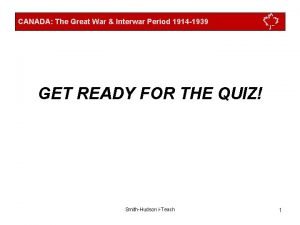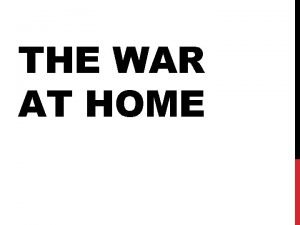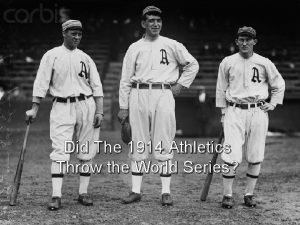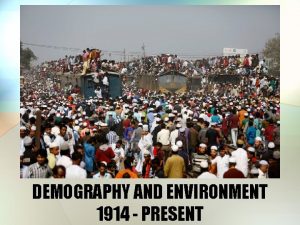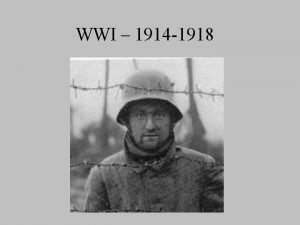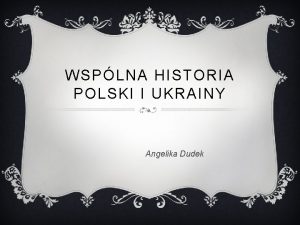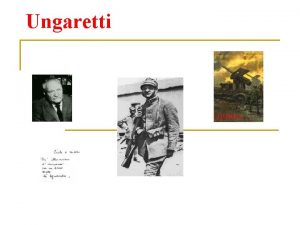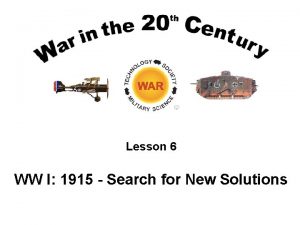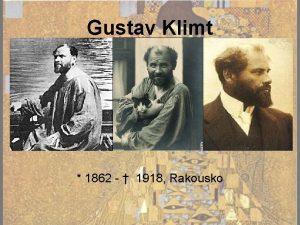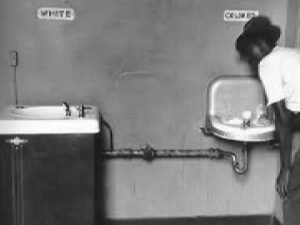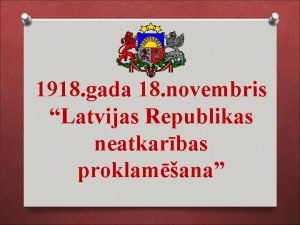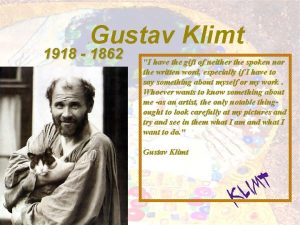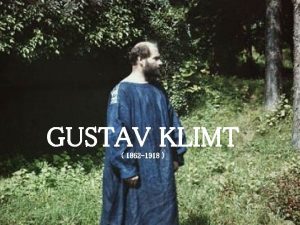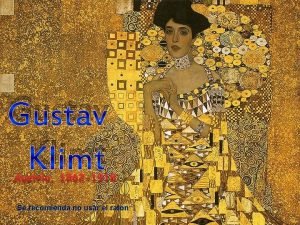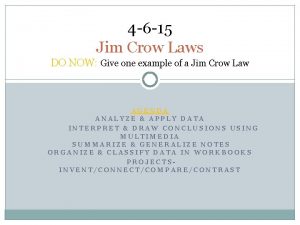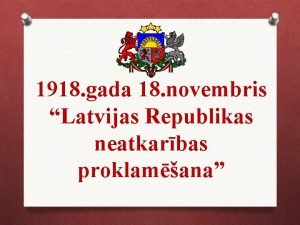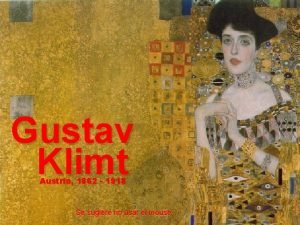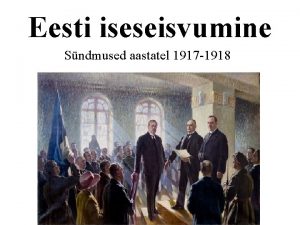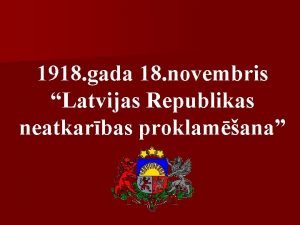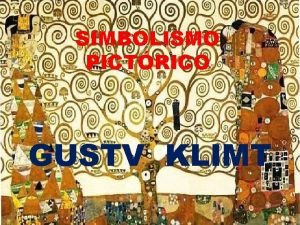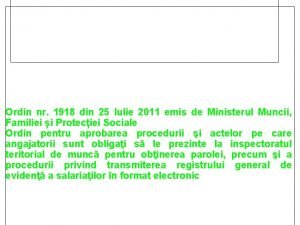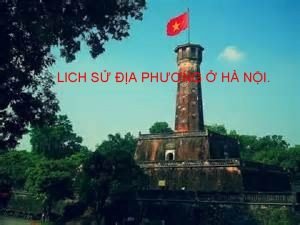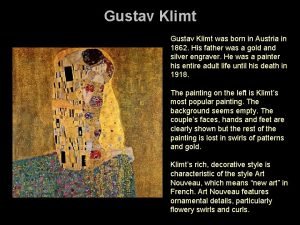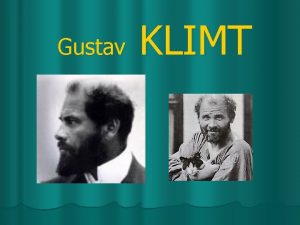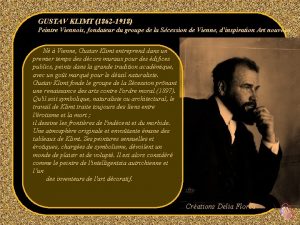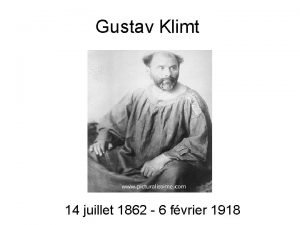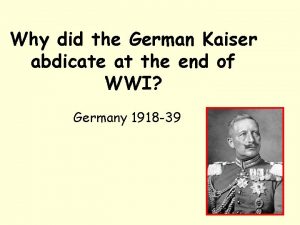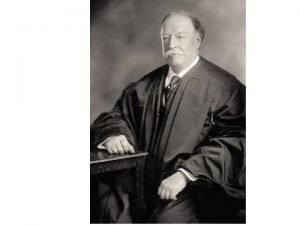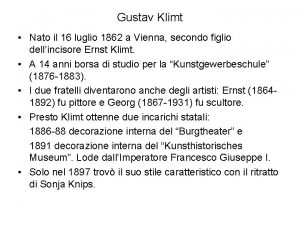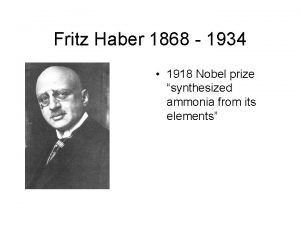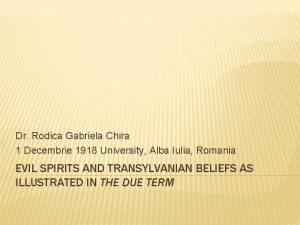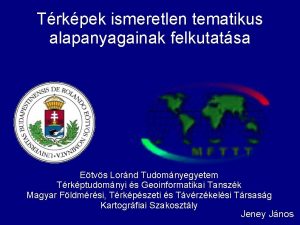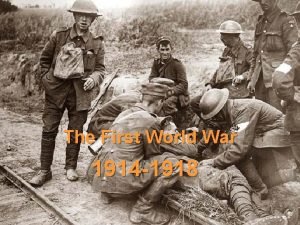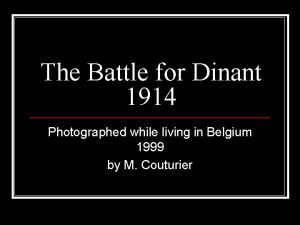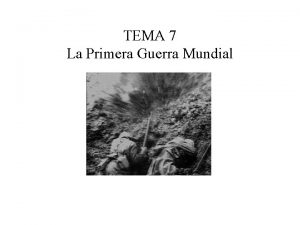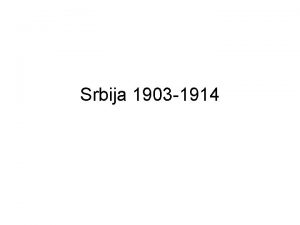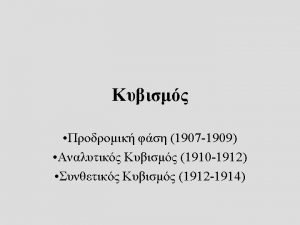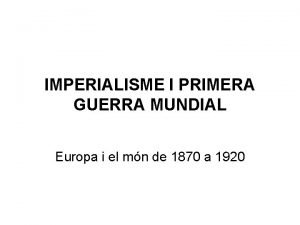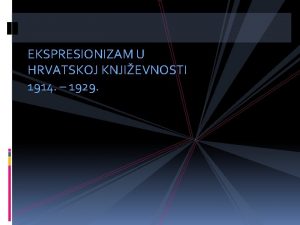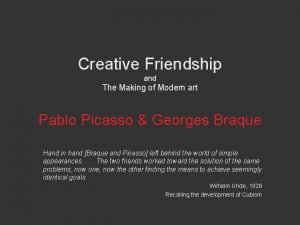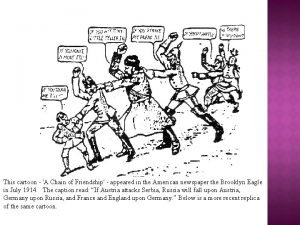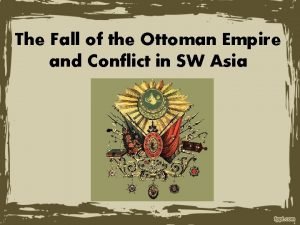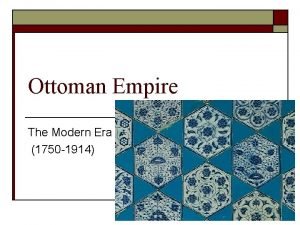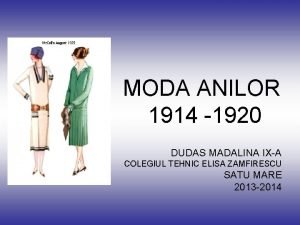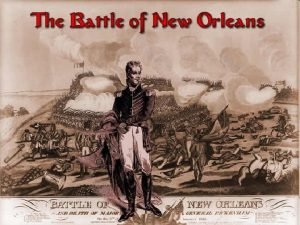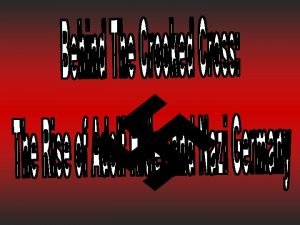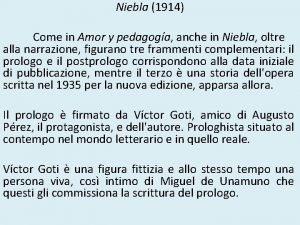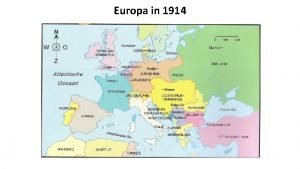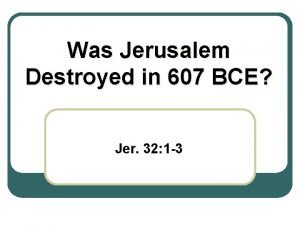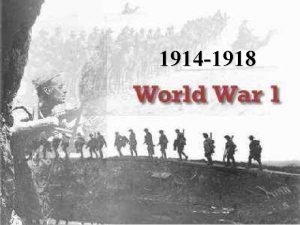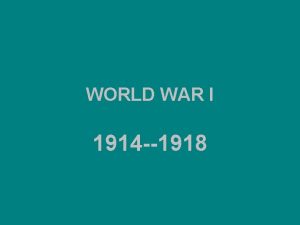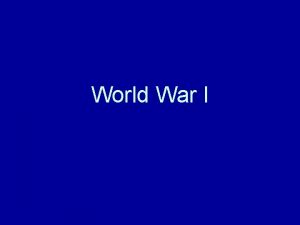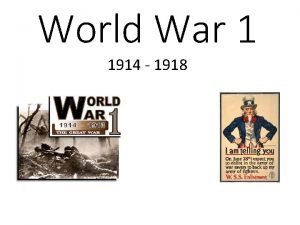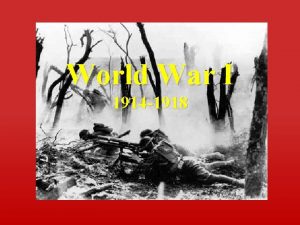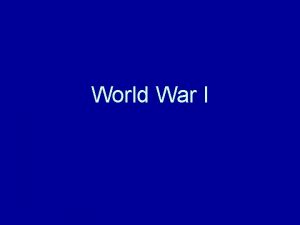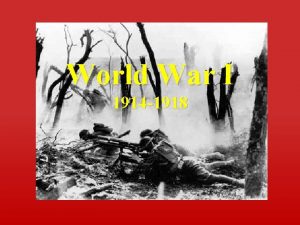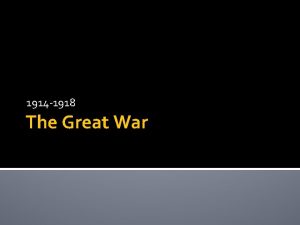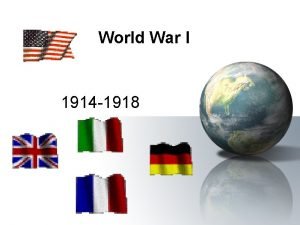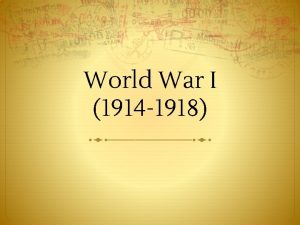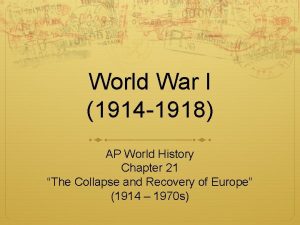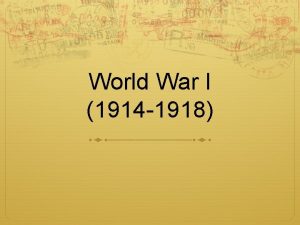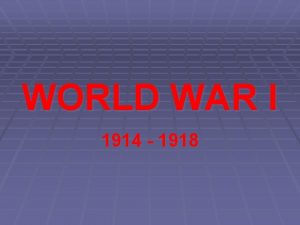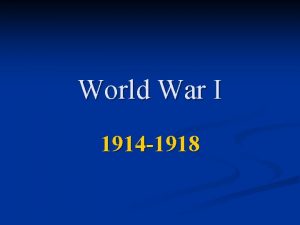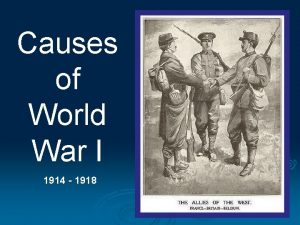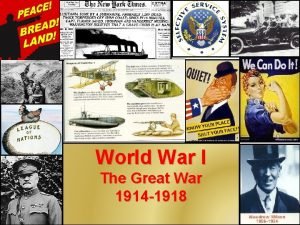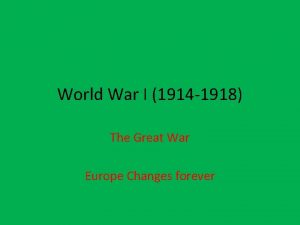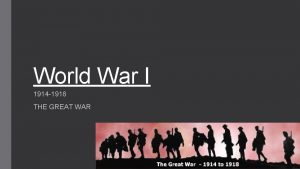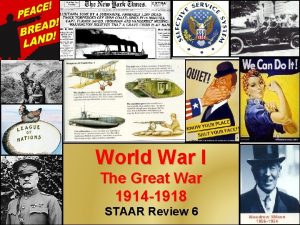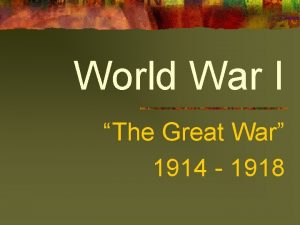World War I 1914 1918 The war to



























































- Slides: 59

World War I (1914 -1918) “The war to end all wars. ”

Causes of World War I M = militarism A = alliance system I = imperialism N = nationalism


Militarism Ø Policy of building up strong armed forces to prepare for war. ØEuropean nations expanded their armies and navies ØNations raced for naval dominance and this led to increased tension (especially Britain and Germany)

Alliances ØAgreement between nations to aid and protect each other. ØTo protect themselves, European powers formed rival alliances ØCentral Powers: Germany and Austria-Hungary and Ottoman Empire ØAllies (Triple Entente): Britain, France and Russia

Imperialism ØPolicy of powerful countries seeking to control the economic and political affairs of weaker countries ØWill lead to rivalries because Britain, France, Germany, Italy, and Russia all scrambled for colonies in Africa, Asia, and the Pacific.

Nationalism Pride on one’s country ØMany people believed that people with a common language and culture should get rid of foreign rule and form their own countries ØNationalism deepened hostility between Austria-Hungary and Russia encouraged Serbs and other minorities in Austria-Hungary to rise up against their rulers. Ø

June 28, 1914 “Murder in Sarajevo” The spark that started WWI was the assassination of Austria’s Archduke Franz Ferdinand.

Arriving at City Hall Leaving Gavrilo Princip

Central Powers (Germany, Austria-Hungary, & the Ottoman Empire) Vs. the Allies (England, France, Russia, and the United States)

A Local Conflict leads to a World War n Map of World with Participants in World War I - Allies in green Central Powers in orange - neutral in grey

Entangled Alliances n n n Austria-Hungary declared war on Serbia on July 28, 1914, a month after the assassination in Sarajevo. Russia, bound by treaty to Serbia, mobilizes its army Germany viewed the Russian mobilization as an act of war against its ally Austria-Hungary and so declared war on Russia France, bound by its treaty to Russia declared war on Germany and, by extension, its ally Austria-Hungary Germany invaded Belgium so Britain declared war on Germany to protect Belgium Three weeks later, Japan declared its military alliance with Britain

The Schlieffen Plan Germany feared a war on two fronts n General Alfred von Schlieffen developed a plan to avoid a two front war n – He believed that Russia would be slow to mobilize so he figured that Germany would have time to quickly defeat France before having to fight Russia This plan required Germany to march through Belgium to get to France… this caused a problem because Britain and other European nations had signed a treaty guaranteeing Belgium neutrality… Britain declares war on Germany in response to the invasion of Belgium.

German Troops enter Belgium

Many people believed this would be a short war… Why? n Weaponry was more efficient than ever before This is the reaction to the declaration of war in Paris n. They were WRONG, the war dragged on until 1918

WWI was a new kind of war, far deadlier than any before.

Weapons of World War I Machine Gun Poison Gas Airplanes Tanks Submarines (U-boats)

Machine Guns 1. ) Transformed warfare 2. ) Able to kill an entire unit of men. 3. ) Created a stalemate during the war.

The First Tanks n Used to breech holes in trench line defenses

Poison Gas 1. ) Used for the 1 st time during WWI. 2. ) French were the 1 st to use it. 3. ) Mustard gas - most lethal of all gases. Odorless & remained active for weeks.

German U-Boats n Hunted in “packs” to attack Allied shipping in the Atlantic

A New Kind of Hero n Baron Manfred von Richthofen n 80 kills

Aerial Combat for the First Time in History

Trench warfare The Germans decided to dig trenches that would provide them protection from the French and British troops. The Allies couldn’t break through this line, causing them to dig trenches. Eventually they spread from the North Sea to the Swiss Frontier.



Conditions of the Trenches n Millions of soldiers roasted under the broiling summer sun or froze through long winters. They share their food with rats and their beds with lice. Pumping out the trenches to avoid trench foot

Trench Foot

Primary Sources on Trenches n Discussion Question: What was your general reaction to these conditions?

No Man’s Land 1. ) Ground between two opposing trenches. 2. ) Contained barbed wire. 3. ) Millions of men died trying to make it across.

Preparing to Enter No-Man’s Land

Over the Top

World War I Battles

Battle of Gallipoli (1915) 1. ) Happened in modern day Turkey. 2. ) British Indian, Australian, and New Zealand troops attacked the Ottomans. 3. ) After 10 months and 200, 000 causalities, the Allies withdrew.



Battle of Verdun (1916) 1. ) Takes place in France 2. ) German forces tried to overwhelm the French, but failed to do so. 3. ) The struggle cost more the halfmillion causalities on both sides.


Battle of the Somme River (1916) 1. ) Takes place in France 2. ) Allied offensive here was even more costly than Verdun. 3. ) In a single day, 60, 000 British soldiers were killed or wounded. After 5 months of fighting only 11 kilometers of territory is gained by the Allies.

By 1917, total war, the channeling of a nation’s entire resources into a war effort, was instituted by almost all nations involved.

Both sides waged a propaganda war, which is the spreading of ideas to promote a cause or damage an opposing cause.



The Sinking of the Lusitania

Major Leaders of World War I

Archduke Franz Ferdinand Austria-Hungary His assassination led to the outbreak of World War I.

Kaiser Wilhelm II Germany Stepped down from power in 1918 and fled into exile to the Netherlands.

King George V England Cousins of Nicolas and Wilhelm, he is the only one able to celebrate victory in 1918

President Woodrow Wilson United States His ideas for peace led to the creation of the League of Nations.

Czar Nicolas II Russia Military defeats and high casualties in WWI led to his murder.

Russia leaves the war (1917) 1. ) Communist revolution brings the Russian monarchy down. 2. ) Vladimir Lenin claims power. 3. ) Russia signs a treaty with Germany that ended Russian participation in WWI.

Finally, the war ends In 1918, both sides of the war continued to fight. With the Kaiser fleeing into exile and Austria-Hungary reeling towards collapse, an armistice was signed. On November 11, 1918, World War I came to an end.

Outcomes and global effects

The colonies’ participation in the war increased demands for independence, which they would not get until later in the 20 th century.

WWI caused the destruction of many empires and governments, including Russia, the Ottoman Empire, Germany, and Austria-Hungary.

Wilson’s Fourteen Points • A list of terms for resolving this and future wars. • He called for an end to secret treaties, freedom of the seas, free trade, and large-scale reductions of arms.

League of Nations n. Created to prevent another world war by encouraging peaceful resolution of problems. n. The USA didn’t join because the League might pull them into another European confrontation.


Treaty of Versailles 1. ) Germany was forced to accept guilt for war (Article 231). War Guilt Clause 2. ) Germany had to pay 30 billion dollars in war damages. 3. ) The treaty severely limited the size of Germany’s military. 4. ) The treaty stripped Germany of their overseas colonies.
 1914 1918
1914 1918 Who reorganized the war industries board in 1918
Who reorganized the war industries board in 1918 1914 world series
1914 world series World population 1914
World population 1914 Eastern front ww1 map
Eastern front ww1 map Mapa ukrainy 1918
Mapa ukrainy 1918 Soldati ungaretti
Soldati ungaretti Shingelfrisyren
Shingelfrisyren Ft17
Ft17 1918-1862
1918-1862 Jim crow (character)
Jim crow (character) 1918 18 novembris
1918 18 novembris Red scare
Red scare Bourbon triumvirate definition
Bourbon triumvirate definition 1 decembrie 1918 proiect
1 decembrie 1918 proiect 1918-1862
1918-1862 1918-1862
1918-1862 1918-1862
1918-1862 Louisiana 1918 poll tax receipt
Louisiana 1918 poll tax receipt 1918 18 novembris
1918 18 novembris 11 listopada 1918 piosenka tekst
11 listopada 1918 piosenka tekst 1918-1862
1918-1862 Eesti iseseisvumine 1918
Eesti iseseisvumine 1918 1918 18 novembris
1918 18 novembris Gustv klimt
Gustv klimt Joodse organisatie ci
Joodse organisatie ci Revisal hg 500 din 2011 download
Revisal hg 500 din 2011 download Lịch sử hà nội từ năm 1802 đến năm 1884
Lịch sử hà nội từ năm 1802 đến năm 1884 1918-1862
1918-1862 El peto klimt
El peto klimt 1918-1862
1918-1862 1918-1862
1918-1862 Wilmshaven
Wilmshaven Hammer v dagenhart
Hammer v dagenhart Nato 1862
Nato 1862 1918 nobel prize winners
1918 nobel prize winners 1 decembrie 1918 university
1 decembrie 1918 university In 1914, who controlled the shaded areas on the map?
In 1914, who controlled the shaded areas on the map? Európa térképe 1914-ben
Európa térképe 1914-ben Colonial empires 1914
Colonial empires 1914 Battle of dinant
Battle of dinant Imperialism map 1914
Imperialism map 1914 Que países participaron en la primera guerra mundial
Que países participaron en la primera guerra mundial Topovsko pitanje
Topovsko pitanje πορτογαλεζα
πορτογαλεζα Causas de la primera guerra mundial imperialismo
Causas de la primera guerra mundial imperialismo Svjetska književnost od 1929 do 1952
Svjetska književnost od 1929 do 1952 Antun branko šimić ekspresionizam
Antun branko šimić ekspresionizam Picasso ma jolie 1914
Picasso ma jolie 1914 Colonial empires 1914
Colonial empires 1914 Chain of friendship cartoon explained
Chain of friendship cartoon explained Ottoman empire 1914
Ottoman empire 1914 Ottoman empire 1914
Ottoman empire 1914 Moda 1920
Moda 1920 In 1814 took a little trip
In 1814 took a little trip Adolf hitler was born
Adolf hitler was born Niebla 1914
Niebla 1914 La treve de noel 1914 film
La treve de noel 1914 film Ottomaanse rijk 1914
Ottomaanse rijk 1914 Evil merodach
Evil merodach
